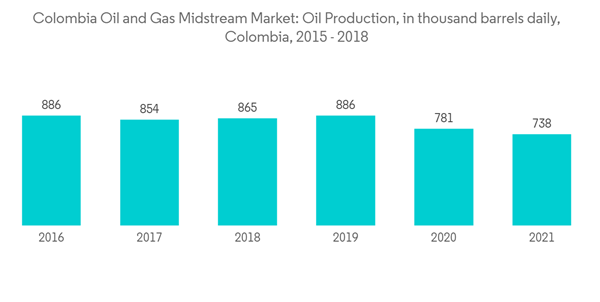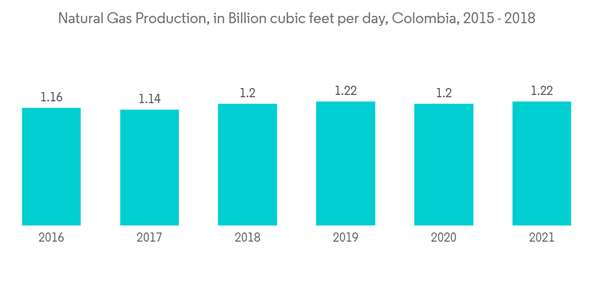The market was negatively impacted by COVID-19. Presently the market has reached pre-pandemic levels.
Factors such as increasing production and increasing oil and gas consumption are expected to boost the demand in the Colombian oil and gas midstream market during the forecast period. Moreover, infrastructure related to the storage and LNG terminals is likely to increase as the demand for oil and gas in the country increases.
However, regular supply disruption by rebels caused unreliability in the industry and created large-scale losses for the pipeline companies. This factor is expected to hinder the growth of the market studied in the coming years.
The Colombian government-owned company is expected to invest in exploring and producing Colombia's oil and gas fields. The investment would likely increase production and create an opportunity for the oil and gas midstream companies in the near future.
Colombia Oil & Gas Midstream Market Trends
Pipeline Sector is Likely to Remain Stagnant
Colombia has an extensive crude oil distribution infrastructure, which is primarily located in the northwest and center of the country, close to most of the crude oil and gas production.Natural gas production in Colombia comes from two primary sources: associated gas from inland fields (Cusiana, Cupiagua, and Pauto Sur) and unassociated gas from offshore fields (Chuchupa field). Ocensa pipeline, with a length of 520 mile (835 km) and a capacity of 590,000 barrels per day, is the largest pipeline in the country.
The Cao Limon-Covenas pipeline, in particular, has been targeted in attacks on critical midstream infrastructure, disrupting the flow of crude oil destined for export. The Cao Limón oil field to the port of Coveas, where most of Colombia's crude oil exports depart the nation, is connected by a pipeline. The most recent attack took place at Cao Limón-Coveas in January 2022.
The oil production decreased in the country, by 5.5%, from 781 thousand barrels per day, in 2020 to 738 thousand barrels per day, in 2021. The oil consumption in the country increased, by 26%, from 277 thousand barrels per day, in 2020 to 349 thousand barrels per day, in 2021.
Hence, pipeline capacity is expected to remain stagnant during the forecast period due to no new investment proposal being made in the pipeline sector. Also, continuous attacks on pipelines by the rebels make them a risky investment.
Increase in Investment is Likely to Drive the Market
To bridge the supply and demand gaps, Colombia imports a modest amount. The Colombian government approved the nation's first LNG import facility in November 2014 due to challenges regarding supply reliability. Buenaventura FSRU Import Terminal, an LNG Terminal, is being constructed in the country. The terminal is expected to come online by 2023.The Pacific Regasification LNG terminal, the project will be close to the port city of Buenaventura on the Pacific coast and can gasify up to 400 million cubic feet per day. The factory is anticipated to start up in 2026.
Moreover, a second LNG import terminal is to be built in Buenaventura on the Pacific coast, according to a Government of Colombia announcement of a tender. As the government attempts to set up incentives, the Buenaventura tender has been postponed numerous times.
Consumption of natural gas decreased in the country, by 3.5%, from 1.3 Billion cubic feet per day, in 2020 to 1.2 billion cubic feet per day, in 2021. Gas production in Colombia increased significantly by 1.2%, year on year, from 1.2 billion cubic feet per day, in 2020 to 1.22 billion cubic feet per day in 2021.
The Colombian oil and gas midstream industry is expected to grow slightly during the forecast period due to an increase in investment and an anticipated increase in oil and gas consumption.
Colombia Oil & Gas Midstream Market Competitor Analysis
The Colombian oil and gas midstream market is consolidated. Some major companies include Ecopetrol SA, Cenit Transporte y Logística de Hidrocarburos SA, Occidental Petroleum Corp, Transportadora de Gas Internacional, and Royal Dutch Shell PLC.Additional benefits of purchasing the report:
- The market estimate (ME) sheet in Excel format
- 3 months of analyst support
This product will be delivered within 2 business days.
Table of Contents
Companies Mentioned (Partial List)
A selection of companies mentioned in this report includes, but is not limited to:
- Exxon Mobil Corporation
- Ecopetrol SA
- Fluor Corporation
- Chevron Corporation
- Shell Colombia SA










